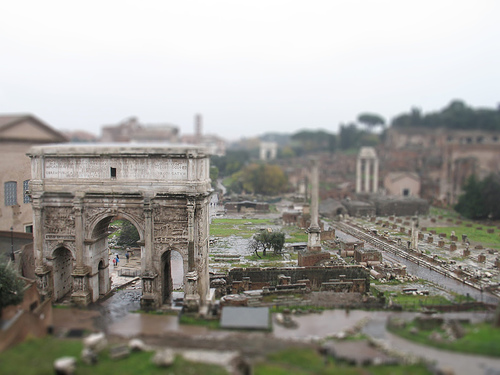Rome Thunderdome
 [Image: Little Rome Ruins by Bernat Gallemí].
[Image: Little Rome Ruins by Bernat Gallemí].An early burst of thunder woke me up this morning, before a brief wash of rain blew through – but what was extraordinary was that the sound of the thunder didn't pass all at once: it kept opening and echoing, as if moving outward through the city to trace the shapes of piazzas, streets, river banks, and alleyways.
There was a kind of Dopplered geometry to it – an acoustic version of Rome exactly opposite the city's angles and walls. Live here long enough, and perhaps you could even tell when a storm has reached the Campo del Fiori – echolocating yourself amidst urban geography – because the thunder has opened out again, getting louder, or more resonant, only then to dampen itself back in a tight squeeze through surrounding alleyways. The sound moves through the city like a spider.
You might say that thunder could be used here as a kind of horizontal space-detection device. It's urban radar: an acoustic sensing of the city that moves through that city, seeking out cracks and passageways. Only to fill those empty spaces with sound.
A guild of blind mapmakers uses thunderstorms to pursue prehistoric radar cartography.
It occurred to me, though, that every city – or, at least, every city with a different street grid – must react to thunder differently. Urban design becomes a direct sonic engagement with the atmosphere through storms, using the unique form of your city as a precise acoustic frame for the sky.
Could there even be building types that funnel the sound of thunder? Like Athanasius Kircher's talking statues, they would be talking buildings: acoustically activated by thunder for the purpose of public spectacle.
You could actually test people with this: put them blindfolded in different locations during foreign thunderstorms and ask them to deduce where they are from the widening concussions of sound around them.
Moscow, Cairo, Rome, Fez. London, Barcelona, New York. All with their own sonic signatures: you pinpoint an aerial detonation and acoustically trace its spatial after-effects.





Comments are moderated.
If it's not spam, it will appear here shortly!
I've always enjoyed the symphonic qualities of thunder. Relating it to echolocation or radar is brilliant. This morning's thunderstorm in my place on the planet will be heard and experienced with a new awareness. Thank you.
Cheers,
peggy
Excellent post and very fitting for this rainy day all the way around the globe in the upper midwest. Thanks!
Best,
Ken
excellent post
I have always appreciated the sounds of storms
Thunderstorms in Cairo are, acoustically, extremely dull. If you want to experience storms loud enough to rattle windows and set of car alarms (honest, guv), few places beat Beirut - the bowl created by the mountains and the sea make for a heart-stopping experience.
I think this goes along with the whole "cloud engineering" theory of planning. Brief and intense thunderstorms are prevelant here in Florida. Some rainy afternoons I love watching storms move in and out of the region on the local radar online. It also seems that here lightning strikes most in large open tracts of land, but that is purely my opinion. The University of Florida has a whole academic program set up to study lightning here:
http://www.lightning.ece.ufl.edu/
sound artists have been exploring the potential of city as sound manipulator for decades. listening to thunder bouncing off walls and passing a speculative riff on the behavior of sound in urban space does not qualify as moving the state of the art forward. if you want to dabble, pay your dues.
Thanks, anonymous (@10:20pm) - these discussions are always improved when someone as pretentious as yourself stops by. Go back to looking in the mirror.
Yeah, Geoff, how dare you?!?! You know you aren't allowed to speculate without first getting an $100,000/year MFA in Sound Installation, spin at a couple of house parties or DJ at the local dive bar during rush week, and evangelizing Fluxus. There is a laundry list of requirements you need check off before you can even apply to be a member of the guild. The committee will not stand for it.
Oh, man - but I just got a $200,000 a year MFA... All for nothing.
I had similar experience while working at the Sperry Chalet in Glacier National Park. The chalet sits on a cirque surrounded on three sides by mountains. http://www.sperrychalet.com/
Whenever there was a storm, the mountains captured the sound and echoed it back and forth, extending and intensifying the effect. Sometimes a single thunder clap would go on for minutes... just incredible. I love the idea of capturing this intentionally on a city-wide scale. Thanks for the post!
Post a Comment